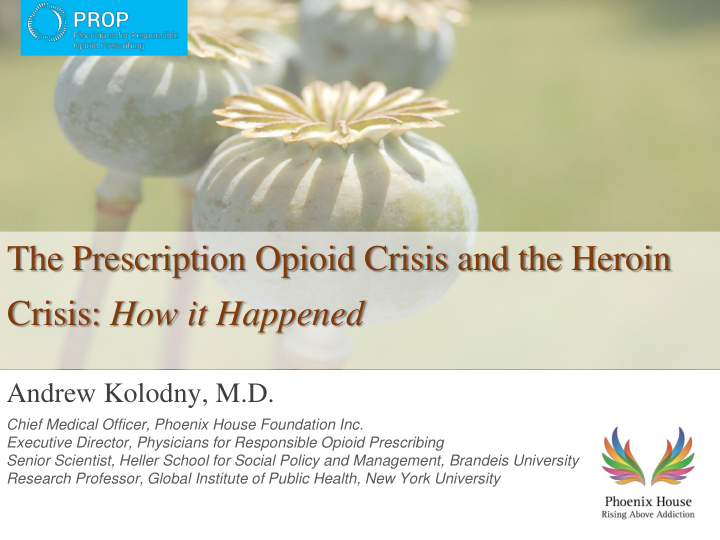



The Prescription Opioid Crisis and the Heroin Crisis: How it Happened Andrew Kolodny, M.D. Chief Medical Officer, Phoenix House Foundation Inc. Executive Director, Physicians for Responsible Opioid Prescribing Senior Scientist, Heller School for Social Policy and Management, Brandeis University Research Professor, Global Institute of Public Health, New York University
Conflict of Interests I have no relevant financial relationships to disclose. 2
Opium 3
Opioid Related Overdose Deaths United States, 1999-2014 Painkillers Heroin Total Opioid 26,000 24,000 22,000 20,000 18,000 16,000 14,000 12,000 10,000 8,000 6,000 4,000 2,000 0 1999 2000 2001 2002 2003 2004 2005 2006 2007 2008 2009 2010 2011 2012 2013 2014 Year
Heroin admissions, by age group & race/ethnicity: 2001- 2011 5
Death rates from overdoses of heroin or prescription opioid pain relievers (OPRs), by age group SOURCE: CDC. Increases in Heroin Overdose Deaths — 28 States, 2010 to 2012 MMWR. 2014, 63:849-854 6
Primary non-heroin opiates/synthetics admission rates, by State (per 100,000 population aged 12 and over) 7
Primary non-heroin opiates/synthetics admission rates, by State (per 100,000 population aged 12 and over) 8
Primary non-heroin opiates/synthetics admission rates, by State (per 100,000 population aged 12 and over) 9
Primary non-heroin opiates/synthetics admission rates, by State (per 100,000 population aged 12 and over) 10
Primary non-heroin opiates/synthetics admission rates, by State (per 100,000 population aged 12 and over) 11
Primary non-heroin opiates/synthetics admission rates, by State (per 100,000 population aged 12 and over) 12
13
Unintentional overdose deaths involving opioid analgesics parallel per capita sales of opioid analgesics in morphine equivalents by year, U.S., 1997-2007 14000 800 * 700 12000 600 10000 500 Number of 8000 400 Opioid sales 6000 Deaths (mg/person) 300 4000 200 2000 100 0 0 '97 '98 '99 '00 '01 '02 '03 '04 '05 '06 '07 Source: National Vital Statistics System, multiple cause of death dataset, and DEA ARCOS * 2007 opioid sales figure is preliminary.
Rates of Opioid Sales, OD Deaths, and Treatment, 1999 – 2010 8 Opioid Sales KG/10,000 Opioid Deaths/100,000 Opioid Treatment Admissions/10,000 7 6 5 Rate 4 3 2 1 0 1999 2000 2001 2002 2003 2004 2005 2006 2007 2008 2009 2010 Year CDC. MMWR 2011
16
17
Dollars Spent Marketing OxyContin (1996-2001) Source: United States General Accounting Office: Dec. 2003, “OxyContin Abuse and Diversion and Efforts to Address the Problem.”
Industry- funded “educational” messages • Physicians are needlessly allowing patients to suffer because of “ opiophobia .” • Opioid addiction is rare in pain patients. • Opioids can be easily discontinued. • Opioids are safe and effective for chronic pain. 19
Industry-funded organizations campaigned for greater use of opioids • Pain Patient Groups • Professional Societies • The Joint Commission • The Federation of State Medical Boards 20
“The risk of addiction is much less than 1%” Porter J, Jick H. Addiction rare in patients treated with narcotics . N Engl J Med. 1980 Jan 10;302(2):123 Cited 824 times (Google Scholar) 21
N Engl J Med. 1980 Jan 10;302(2):123. 22
Controlling the epidemic: A Three-pronged Approach • Prevent new cases of opioid addiction. • Treatment for people who are already addicted • Reduce supply from pill mills and the black- market. 25
How the opioid lobby frames the problem: Source: Slide presented by Lynn R. Webster MD at FDA meeting on hydrocodone upscheduling, January 25 th , 2013.
This is a false dichotomy Opioid harms are not limited to so- called “drug abusers” 35% met DSM V criteria for an opioid use disorder 1 “ Drug Abusers ” Pain Patients 92% of opioid OD decedents were prescribed opioids for chronic pain. 2 1. Boscarino JA, Rukstalis MR, Hoffman SN, et al. Prevalence of prescription opioid-use disorder among chronic pain patients: comparison of the DSM-5 vs. DSM-4 diagnostic criteria. J Addict Dis. 2011;30:185-194. 2. Johnson EM, Lanier WA, Merrill RM, et al. Unintentional Prescription Opioid-Related Overdose Deaths: Description of Decedents by Next of Kin or Best Contact, Utah, 2008-2009. J Gen Intern Med. 2012 Oct 16.
President Obama discussing the opioid addiction epidemic in West Virginia
Summary • The U.S. is in the midst of a severe epidemic of opioid addiction • To bring the epidemic to an end: – We must prevent new cases of opioid addiction – We must ensure access to treatment for people already addicted
Recommend
More recommend